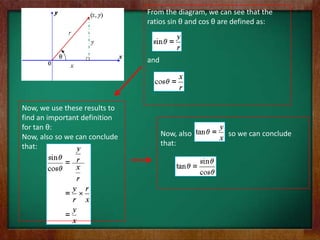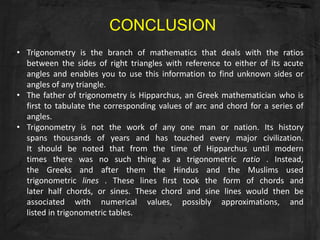History of trigonometry2
- 1. NURINA AYUNINGTYAS (093174003) AND DWITYA BUDI ANGGRAENY (093174046) Present:
- 2. HISTORY OF TRIGONOME TRY
- 3. INTRODUCTION
- 4. Trigonometry developed from the study of right-angled triangles by applying their relations of sides and angles to the study of similar triangles. The word trigonometry comes from the Greek words "trigonon" which means triangle, and "metria" which means measure. The term trigonometry was first invented by the German mathematician Bartholomaeus Pitiscus, in his work, Trigonometria sive de dimensione triangulea, and first published 1595. This is the branch of mathematics that deals with the ratios between the sides of right triangles with reference to either of its acute angles and enables you to use this information to find unknown sides or angles of any triangle.
- 5. The primary use of trigonometry is for operation, cartography, astronomy and navigation, but modern mathematicians has extended the uses of trigonometric functions far beyond a simple study of triangles to make trigonometry indispensable in many other areas. Especially astronomy was very tightly connected with trigonometry, and the first presentation of trigonometry as a science independent of astronomy is credited to the Persian Nasir ad-Din in the 13 century.
- 6. development
- 7. EARLY TRIGONOMETRY Trigonometric functions have a varied history. The old Egyptians looked upon trigonometric functions as features of similar triangles, which were useful in land surveying and when building pyramids. The old Babylonian astronomers related trigonometric functions to arcs of circles and to the lengths of the chords subtending the arcs. They kept detailed records on the rising and setting of stars, the motion of the planets, and the solar and lunar eclipses, all of which required familiarity with angular distances measured on the celestial sphere.
- 9. The first trigonometric table was apparently compiled by Hipparchus of Nicaea (180 - 125 BC), who is now consequently known as "the father of trigonometry." Hipparchus was the first to tabulate the corresponding values of arc and chord for a series of angles.
- 10. Menelaus of Alexandria (ca. 100 A.D.) wrote in three books his Sphaerica. In Book I, he established a basis for spherical triangles analogous to the Euclidean basis for plane triangles. Book II of Sphaerica applies spherical geometry to astronomy. And Book III contains the "theorem of Menelaus". He further gave his famous "rule of six quantities".
- 11. One of his most important theorems state that if the three lines forming a triangle are cut by a transversal, the product of the length of three segments which have no common extremity is equal to the products of the other three. This appears as a lemma to a similar proposition relating to spherical triangle, ÔÇ£the chords of three segments doubledÔÇØ replacing ÔÇ£three segments.ÔÇØ The proposition was often known in the Middle Ages as the regula sex quantitatum or rule of six quantities because of the six segments involved.
- 13. Claudius Ptolemy (ca. 90 - ca. 168 A.D.) expanded upon Hipparchus' Chords in a Circle in his Almagest, or the Mathematical Syntaxes . The thirteen books of the Almagest are the most influential and significant trigonometric work of all antiquity. A theorem that was central to Ptolemy's calculation of chords was what is still known today as Ptolemy's theorem.
- 14. PtolemyÔÇÖs theorem Ptolemy's theorem is a relation in Euclidean geometry between the four sides and two diagonals of a cyclic quadrilateral (a quadrilateral whose vertices lie on a common circle). The theorem is named after the Greek astronomer and mathematician Ptolemy (Claudius Ptolemaeus). lACl ┬À lBDl = lABl ┬À lCDl + lBCl ┬À lADl This relation may be verbally expressed as follows: If a quadrilateral is inscribed in a circle then the sum of the products of its two pairs of opposite sides is equal to the product of its diagonals.
- 17. MadhavaÔÇÖs work Madhava's sine table is the table of trigonometric sines of various angles constructed by the 14th century Kerala mathematician-astronomer Madhava of Sangamagrama. The table lists the trigonometric sines of the twenty-four angles 3.75┬░, 7.50┬░, 11.25┬░, ... , and 90.00┬░ (angles that are integral multiples of 3.75┬░, i.e. 1/24 of a right angle, beginning with 3.75 and ending with 90.00). The table is encoded in the letters of Devanagari using the Katapayadi system.
- 18. ISLAMIC MATHEMATICS ÔÇó In the early 9th century, Muhammad ibn Musa al-Khwarizmi produced accurate sine and cosine tables, and the first table of tangents. He was also a pioneer in spherical trigonometry. ÔÇó In 830, Habash al-Hasib al-Marwazi produced the first table of cotangents.
- 19. ÔÇó By the 10th century, in the work of Abu al-Wafa' al- Buzjani, Muslim mathematicians were using all six trigonometric functions. He also developed the following trigonometric formula: ÔÇó sin (2x) = 2 sin (x) cos (x).
- 21. note: cos (A+B) = cosAcosB - sinAsinB cos (A-B) = cosAcosB + sinAsinB so cos (A+B) + cos (A- B) = cosAcosB ÔÇô sinAsinB + cosAcosB + sinAsinB = 2cosAcosB
- 22. CHINESE MATHEMATICS ÔÇó The polymath Chinese scientist, mathematician and official, Shen Kuo (1031ÔÇô1095) used trigonometric functions to solve mathematical problems of chords and arcs. ÔÇó Sal Restivo writes that Shen's work in the lengths of arcs of circles provided the basis for spherical trigonometry developed in the 13th century by the mathematician and astronomer Guo Shoujing (1231ÔÇô1316). ÔÇó Guo Shoujing used spherical trigonometry in his calculations to improve the calendar system and Chinese astronomy. ÔÇó Despite the achievements of Shen and Guo's work in trigonometry, another substantial work in Chinese trigonometry would not be published again until 1607, with the dual publication of Euclid's Elements by Chinese official and astronomer Xu Guangqi (1562ÔÇô1633) and the Italian Jesuit Matteo Ricci (1552ÔÇô1610).
- 23. EUROPEAN MATHEMATICS ÔÇó Regiomontanus was perhaps the first mathematician in Europe to treat trigonometry as a distinct mathematical discipline, in his De triangulis omnimodus written in 1464, as well as his later Tabulae directionum which included the tangent function, unnamed. ÔÇó The Opus palatinum de triangulis of Georg Joachim Rheticus, a student of Copernicus, was probably the first in Europe to define trigonometric functions directly in terms of right triangles instead of circles, with tables for all six trigonometric functions; this work was finished by Rheticus' student Valentin Otho in 1596. ÔÇó In the 17th century, Isaac Newton and James Stirling developed the general Newton-Stirling interpolation formula for trigonometric functions.
- 24. ÔÇó In the 18th century, Leonhard Euler's Introductio in analysin infinitorum (1748) was mostly responsible for establishing the analytic treatment of trigonometric functions in Europe, defining them as infinite series and presenting "Euler's formula" eix = cosx + isinx. ÔÇó Also in the 18th century, Brook Taylor defined the general Taylor series and gave the series expansions and approximations for all six trigonometric functions. ÔÇó The works of James Gregory in the 17th century and Colin Maclaurin in the 18th century were also very influential in the development of trigonometric series.
- 25. Proof of EulerÔÇÖs formula Step 1: Step 3: For several number x: Because i2 = -1 by definition, we let y = cos x + isin x have -sin x + icos x = i(isin x + cos x) i is the unreal element Step 6: Step 7: Step 8: Now, if we get the Now place e the power of Now combining the steps, integral of all side we equal sides, we get: we get: get: y = eix [Because e ln y = y] eix = cos x + isin x ln y = ix
- 26. From the diagram, we can see that the ratios sin ╬© and cos ╬© are defined as: and Now, we use these results to find an important definition for tan ╬©: Now, also so we can conclude Now, also so we can conclude that: that:
- 27. Also, for the values in the diagram, we can use Pythagoras' Theorem and obtain: y2 + x2 = r2 Dividing through by r2 gives us: so we obtain the important result: sin2 ╬© + cos2 ╬© = 1 sin2╬© + cos2 ╬© = 1 through by cos2╬© gives us: sin2╬© + cos2 ╬© = 1 through by sin2╬© gives us: So So 1 + cot2 ╬© = csc2 ╬© tan2 ╬© + 1 = sec2 ╬©
- 28. CONCLUSION ÔÇó Trigonometry is the branch of mathematics that deals with the ratios between the sides of right triangles with reference to either of its acute angles and enables you to use this information to find unknown sides or angles of any triangle. ÔÇó The father of trigonometry is Hipparchus, an Greek mathematician who is first to tabulate the corresponding values of arc and chord for a series of angles. ÔÇó Trigonometry is not the work of any one man or nation. Its history spans thousands of years and has touched every major civilization. It should be noted that from the time of Hipparchus until modern times there was no such thing as a trigonometric ratio . Instead, the Greeks and after them the Hindus and the Muslims used trigonometric lines . These lines first took the form of chords and later half chords, or sines. These chord and sine lines would then be associated with numerical values, possibly approximations, and listed in trigonometric tables.
- 29. REFERENCES ÔÇó http://aleph0.clarku.edu/~djoyce/ma105/trighist.html ÔÇó http://home.c2i.net/greaker/comenius/9899/historytrigonome try/Trigonometry1.html ÔÇó http://en.wikipedia.org/wiki/History_of_trigonometry ÔÇó http://www.bookrags.com/research/fundamental- trigonometric-functions-wom/


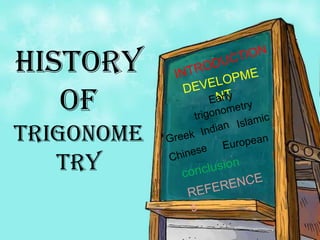

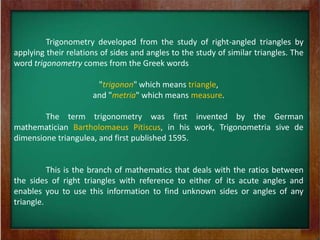
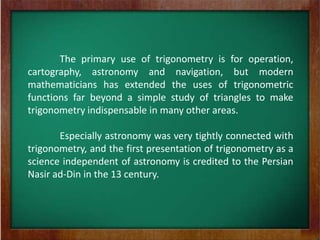

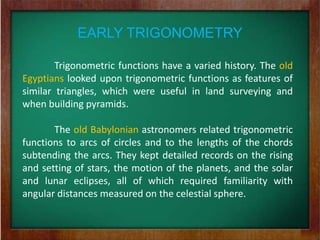
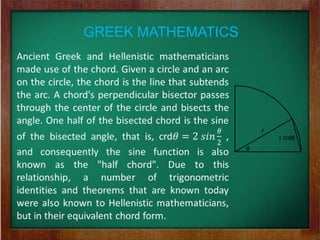

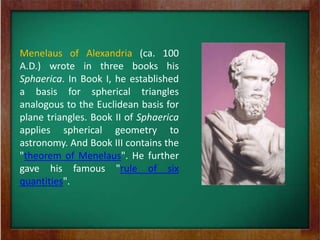
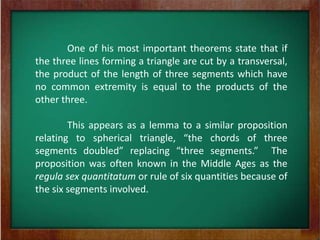

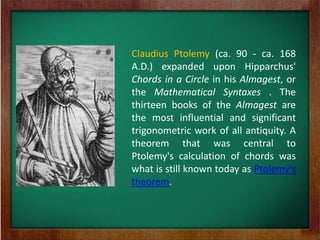
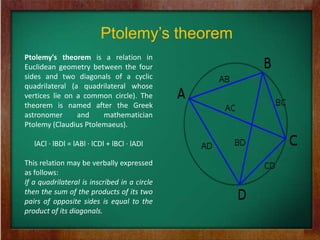
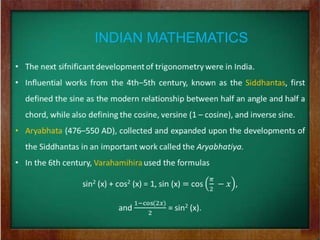
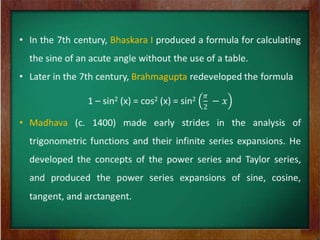
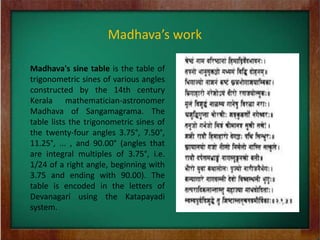


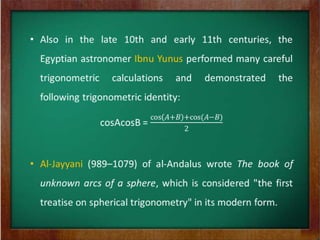


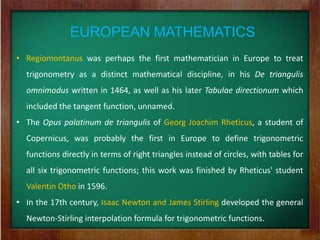

![Proof of EulerÔÇÖs formula
Step 1:
Step 3:
For several number x:
Because i2 = -1 by definition, we
let y = cos x + isin x
have
-sin x + icos x = i(isin x + cos x)
i is the unreal element
Step 6: Step 7: Step 8:
Now, if we get the Now place e the power of Now combining the steps,
integral of all side we equal sides, we get: we get:
get: y = eix [Because e ln y = y] eix = cos x + isin x
ln y = ix](https://image.slidesharecdn.com/historyoftrigonometry2-101217075404-phpapp02/85/History-of-trigonometry2-25-320.jpg)
